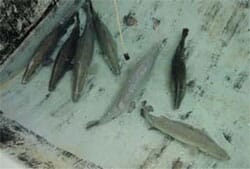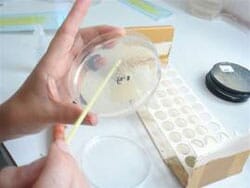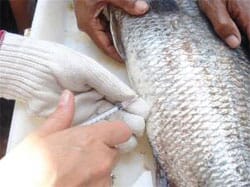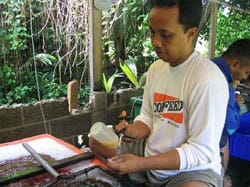Laboratory studies show that a single intraperitoneal (IP) injection vaccination in Asian sea bass juveniles with 0.1 ml of Norvax Strep Si provided a maximal level of protection as soon as one week after vaccination. Maximum protection remained for up to at least 12 weeks under laboratory conditions.
 |
|
Experimental fish
|
 |
|
Culturing challenge bacteria
|
 |
|
Intraperitoneal challenge
|
The objective of the experiment was to evaluate the duration of immunity of the vaccine under routine farming conditions. All vaccinated fish received an IP injection at the fingerling stage (about 10 g) with Norvax Strep Si. In the farm, both vaccinated and non-vaccinated (control) fish were challenged with a virulent strain of S. iniae at three different sizes: 300 g (5 months old), approximately 1 kg (12-16 months old) and approximately 2-3 kg (approx. 2 years old). A total of 107 fish were experimentally challenged with S iniae (see table). After challenge, vaccinated and control fish were held in the same tank. Vaccinated fish were identified by tail clipping. Challenge material was obtained from diseased fish as a result of a Streptococcus iniae outbreak that took place in the same farm just prior to commencement of the experiment. The farm isolate went through one culture passage on a non-selective media before challenge.
Conscious that the introduction of pathogens could put the farm at risk, the S. iniae isolate was not actually introduced into the commercial farming area and additional precautions were taken to prevent the spread of the challenge material on the farm. These included conducting the challenge experiments in an isolated zone of the farm distant from the sea cage production units. Once the three challenge experiments were terminated, the remaining fish were humanely sacrificed and all holding tanks were thoroughly disinfected.
The trial was terminated 8 days post challenge or when no mortality occurred for 2 days. In fish of 300 g, 2.8% of vaccinated fish died and 26.7% of control fish died, resulting in a Relative Percent Survival (RPS) value of 89.6%. In fish of both 1 and 2-3 kg, no mortality was observed in the vaccinated groups. In contrast, mortality in the 1 and 2-3 kg control groups were 14.3% and 72.4%, respectively, giving rise to RPS values of 100% in both vaccinated groups.
| Table: Fish size, fish numbers, % mortality in vaccinated and control fish and corresponding RPS values after S. iniae challenge in Norvax Strep Si-vaccinated fish. | |||||
| Condition | Fish size | Fish age | Fish numbers | % mortality | RPS |
| Vaccinated | 300 g | 5 months | 36 | 2.78% | 89.6 |
| Control | 300 g | 5 months | 15 | 26.67% | |
| Vaccinated | 1 kg | 12 months | 14 | 0% | 100 |
| Control | 1 kg | 16 months | 14 | 14.3% | |
| Vaccinated | 2-3 kg | 2 years+ | 14 | 0% | 100 |
| Control | 2-3 kg | 2 years+ | 14 | 71.4% | |
Overall, this experiment shows that a single injection vaccination of Norvax Strep Si in Asian seabass fingerlings gives full protection against S. iniae infections for the entire duration of the production cycle, up to 18 months post vaccination under farm conditions.
Observations from Bambang Wahjudi
(Farm manager of Fega Marikultura, Indonesia). |
Fega marikultura is developing a fish farm in the Seribu Islands, North of Jakarta, Indonesia. The grow-out concerns the tropical Sea-bass or Barramundi, Lates calcarifer, offshore in circular PE floating cages.
During the pilot phase we faced large outbreaks of disease characterized by the sudden onset of mortality. Typically, tons of fish were killed in less than one week during these outbreaks. The team of Intervet Norbio Singapore identified the killer as Streptococcus iniae and, after successful laboratory tests; we were able to host the field trials for the new vaccine against S. iniae which was rapidly developed by Intervet.
Now, since more than two years, we are routinely vaccinating by injection all our juveniles of around 8-10 g weight in onshore tanks before sending them to our pregrowing cages. Since we have begun the routine vaccination of our juveniles (already more than one million fish) we dont see anymore huge outbreak of mortalities. But there are always challenges ahead. Indeed, although vaccination has reduced the impact of the infection we do still encounter low level mortality associated with S. iniae, typically after periods of rough weather or strong currents. Our current hypothesis is that our vaccination procedure is not yet fully standardized and that a small percentage of juveniles are either not vaccinated or are inappropriately vaccinated.
In conclusion, Streptococcus iniae is a permanent component of our culture ecosystem and thanks to our co-operation with Intervet, vaccination looks to be the best way to live with it.


